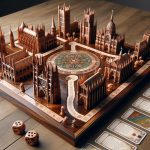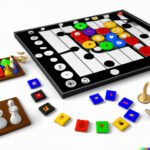The Cathedral board game, a classic strategy game, has been captivating players for decades with its unique gameplay and challenging tactics. This game combines elements of spatial awareness, strategic placement, and forward planning to create an engaging experience for all who play. Understanding the intricate strategies involved in Cathedral is crucial to success in this competitive board game.
With origins dating back to the 1970s, Cathedral has stood the test of time as a beloved tabletop game that requires skill, cunning, and a bit of luck. Players take turns strategically placing their pieces on the board in an attempt to enclose their opponent’s cathedral or restrict their movements. The basic rules are simple yet nuanced, offering players a depth of gameplay that rewards clever thinking and strategic foresight.
Strategy plays a fundamental role in Cathedral, as every move can make or break your chances of victory. From planning your initial placements to blocking your opponent’s advances, each decision must be carefully calculated to secure control of the board and outmaneuver your rival. By mastering the art of spatial manipulation and understanding how to leverage the layout of the game board to your advantage, players can elevate their gameplay and dominate their opponents with strategic prowess.
Understanding the Objective
The objective in the Cathedral board game is to strategically place your buildings on the board in a way that blocks your opponent from expanding their territory while securing your own. The game board consists of various spaces representing different types of terrain, such as water and grass, along with buildings of different sizes that players must fit within the boundary lines.
By blocking your opponent’s movement and strategically placing your own pieces, you aim to control more territory by the end of the game.
To achieve this goal, players must carefully plan their moves and anticipate their opponent’s next steps. One key strategy is to focus on controlling the center of the board early in the game, as it gives you better opportunities to expand in multiple directions while limiting your opponent’s options. Additionally, understanding how each piece can be placed and rotated to maximize coverage is crucial in securing key areas on the board.
Experienced players often use a combination of offensive and defensive strategies to outmaneuver their opponents. This could involve sacrificing smaller pieces strategically to block an opponent’s path or setting up traps to lure them into conceding valuable territory. By mastering these tactics and adapting them based on each game situation, players can increase their chances of success in Cathedral board game competitions.
| Key Strategies | Details |
|---|---|
| Control Center Early | Focus on occupying central squares for strategic expansion. |
| Use Offensive & Defensive Tactics | Combine attacking opponents’ positions with securing your own area. |
| Adaptation | Adjust strategies according to changing dynamics during gameplay. |
Importance of Strategy in Cathedral
The Cathedral board game is not just about placing pieces on a board; it is a strategic battle of wits and planning. The importance of strategy in Cathedral cannot be overstated, as it can make the difference between victory and defeat. By formulating a solid strategy, players can outmaneuver their opponents and secure their dominance on the board.
To excel in the Cathedral board game, players must carefully consider their moves and plan ahead to outsmart their opponents. Here are some reasons why strategy is crucial in this competitive game:
1. Positioning: Strategic placement of your pieces is essential in Cathedral. By strategically positioning your pieces, you can create blockades to hinder your opponent’s movements or open up pathways for your own pieces to advance.
2. Anticipating Opponent Moves: A good strategy involves predicting your opponent’s next move and planning accordingly. By anticipating your opponent’s strategies, you can counter their moves effectively and gain an advantage on the board.
3. Flexibility: While having a well-thought-out strategy is important, being adaptable is equally crucial in Cathedral. Players must be able to adjust their strategies according to changing circumstances on the board to stay ahead of the competition.
Analyzing the Game Board
Understanding the Layout of the Cathedral Board
The Cathedral board consists of a grid with varying shapes and sizes of buildings, streets, and parks. Players take turns placing these pieces strategically on the board to ultimately create an enclosed area known as the cathedral.
It’s crucial to have a good grasp of the layout of the board to anticipate your opponent’s moves and plan your own strategy accordingly. Understanding how each piece can fit together and block off areas will give you a significant advantage in controlling key parts of the board.
Utilizing Strategic Placement
One key aspect of mastering Cathedral is knowing how to place your buildings effectively on the board. By strategically blocking off sections and creating barriers for your opponent, you can control the flow of the game and limit their options.
Aim to create clusters of buildings that are difficult to penetrate, forcing your opponent to navigate around them or risk being shut out altogether. Additionally, keeping an eye on potential cathedral locations and actively working towards enclosing those areas can put you in a strong position to secure victory.
Visioning Future Moves
As you analyze the layout of the Cathedral board, it’s essential to think not only about your current move but also about future possibilities. Anticipate where your opponent might try to expand next or which areas they are likely targeting for their cathedral enclosure.
By thinking a few steps ahead and planning your moves strategically, you can stay one step ahead in the game. This foresight will help you adapt your strategies as the game progresses and make informed decisions that set you up for success in achieving your objective of dominating the board and claiming victory in Cathedral.
Key Tips for Beginners
Learn the Pieces and Their Abilities
Before diving into a game of Cathedral, it’s essential to familiarize yourself with the different pieces and their respective abilities. Each piece has a specific shape and size, which affects how you can place them on the board. Understanding the characteristics and limitations of each piece will give you a strategic advantage when planning your moves.
Control the Center of the Board
One key tip for beginners in Cathedral is to focus on controlling the center of the board. By securing this central area, you limit your opponent’s options for placing their pieces strategically. This can give you an edge in expanding your territory while restricting your opponent’s movements. Keep an eye on opportunities to block off areas or surround key positions on the board to gain control over crucial spaces.
Plan Ahead and Anticipate Your Opponent’s Moves
Successful players in Cathedral excel at planning ahead and anticipating their opponent’s moves. As a beginner, it’s important to think not only about your next move but also several steps ahead. Consider how each placement will impact future turns and potential outcomes. By thinking strategically and predicting your opponent’s plays, you can position yourself for success in the game.
As you start playing Cathedral, remember that practice is key to improving your skills and mastering the game. By implementing these key tips for beginners and staying attentive to board dynamics, you can enhance your gameplay and work towards becoming a formidable competitor in Cathedral board game strategy.
Advanced Strategies
When it comes to the Cathedral board game, mastering advanced strategies can be the key to dominating your opponents and increasing your chances of winning. While beginners may focus on basic tactics to get started, experienced players know that a deeper understanding of the game mechanics and strategic elements can make all the difference in competitive play.
Here are some advanced strategies to consider when playing Cathedral:
- Control the Center: Securing control of the center of the board can give you a significant advantage. By placing your pieces strategically in this area, you can block your opponent’s movements and limit their options, while also expanding your own territory.
- Anticipate Your Opponent’s Moves: Experienced players often think several moves ahead and anticipate their opponent’s strategy. By predicting what your opponent might do next, you can plan your own moves accordingly and stay one step ahead.
- Adapt Your Strategy: Being flexible in your approach is crucial in Cathedral. As the game progresses and the board evolves, it’s important to adapt your strategy based on the changing landscape. Keep an eye on opportunities to optimize your position and adjust your tactics as needed.
By incorporating these advanced strategies into your gameplay, you can elevate your performance in Cathedral and increase your chances of success. Remember that practice makes perfect, so don’t be afraid to experiment with different tactics and learn from each game you play. With dedication and strategic thinking, you can enhance your skills and become a formidable player in Cathedral board game competitions.
Common Mistakes to Avoid
When playing the Cathedral board game, it is important to be aware of common mistakes that players often make and how to avoid them. One of the most frequent errors is not planning ahead strategically. In Cathedral, each player aims to strategically place buildings and block their opponents from expanding while claiming space for themselves. Failing to plan your moves in advance can lead to missed opportunities and losing control of the game board.
Another common mistake is underestimating the importance of blocking your opponent’s moves. Blocking plays a crucial role in Cathedral as it can disrupt your opponent’s expansion plans and give you an advantage. By focusing solely on your own pieces and neglecting to block your opponent, you are missing out on a key strategy that could help secure your victory.
Furthermore, a mistake that beginners often make is not considering the value of every move they make. Each placement of a building or wall in Cathedral should be well thought out, taking into account both immediate benefits and future possibilities. It is essential to consider how each move will impact the overall game and contribute to achieving your strategic goal of controlling more space on the board than your opponent.
| Common Mistakes | How to Avoid |
|---|---|
| Not planning ahead strategically | Think several steps ahead and anticipate your opponent’s moves |
| Underestimating the importance of blocking | Focus on disrupting your opponent’s plans by strategic placement of buildings and walls |
| Not considering the value of every move | Think about the short-term benefits and long-term implications of each placement on the board |
Winning Strategies
In conclusion, mastering the Cathedral board game requires a deep understanding of its rules, objectives, and most importantly, strategic gameplay. The game’s rich history and intricate board layout provide players with countless opportunities to develop winning strategies and outwit their opponents. Whether you are a beginner looking to learn the ropes or an experienced player seeking to dominate in competitions, honing your Cathedral board game strategy is crucial for success.
One key aspect to keep in mind when formulating your strategy is to carefully analyze the game board. Understanding how to maneuver your pieces effectively within the constraints of the board layout can give you a significant advantage over your competition. Additionally, paying attention to common mistakes that players often make can help you avoid pitfalls and stay ahead in the game.
For those aiming to take their Cathedral gameplay to the next level, delving into advanced strategies is essential. By exploring more complex tactics and thinking several steps ahead, experienced players can fine-tune their skills and elevate their performance in competitive settings. Ultimately, by combining a solid understanding of the game with well-crafted strategies tailored to your playstyle, you can increase your chances of achieving victory and dominating Cathedral board game competitions.
Frequently Asked Questions
What Is the Strategy for the Game Cathedral?
The strategy for the game Cathedral involves carefully planning your moves to strategically block your opponent while also trying to expand your own territory. It’s important to think several steps ahead and anticipate your opponent’s moves to secure a victory.
Is Cathedral a Good Board Game?
Cathedral is considered a good board game by many players due to its combination of strategy, skill, and quick gameplay. It offers a unique and engaging experience that keeps players coming back for more. Its simple rules make it accessible for all ages.
How Long to Beat Cathedral?
The time it takes to beat Cathedral can vary depending on the players’ skill levels and strategies. On average, a game of Cathedral usually lasts between 15 to 30 minutes. However, this can change based on how quickly each player makes their moves and whether they are experienced or new to the game.

I love playing all kinds of games – from classics like Monopoly to modern favourites like Ticket to Ride.
I created this blog as a way to share my love of board games with others, and provide information on the latest releases and news in the industry.





